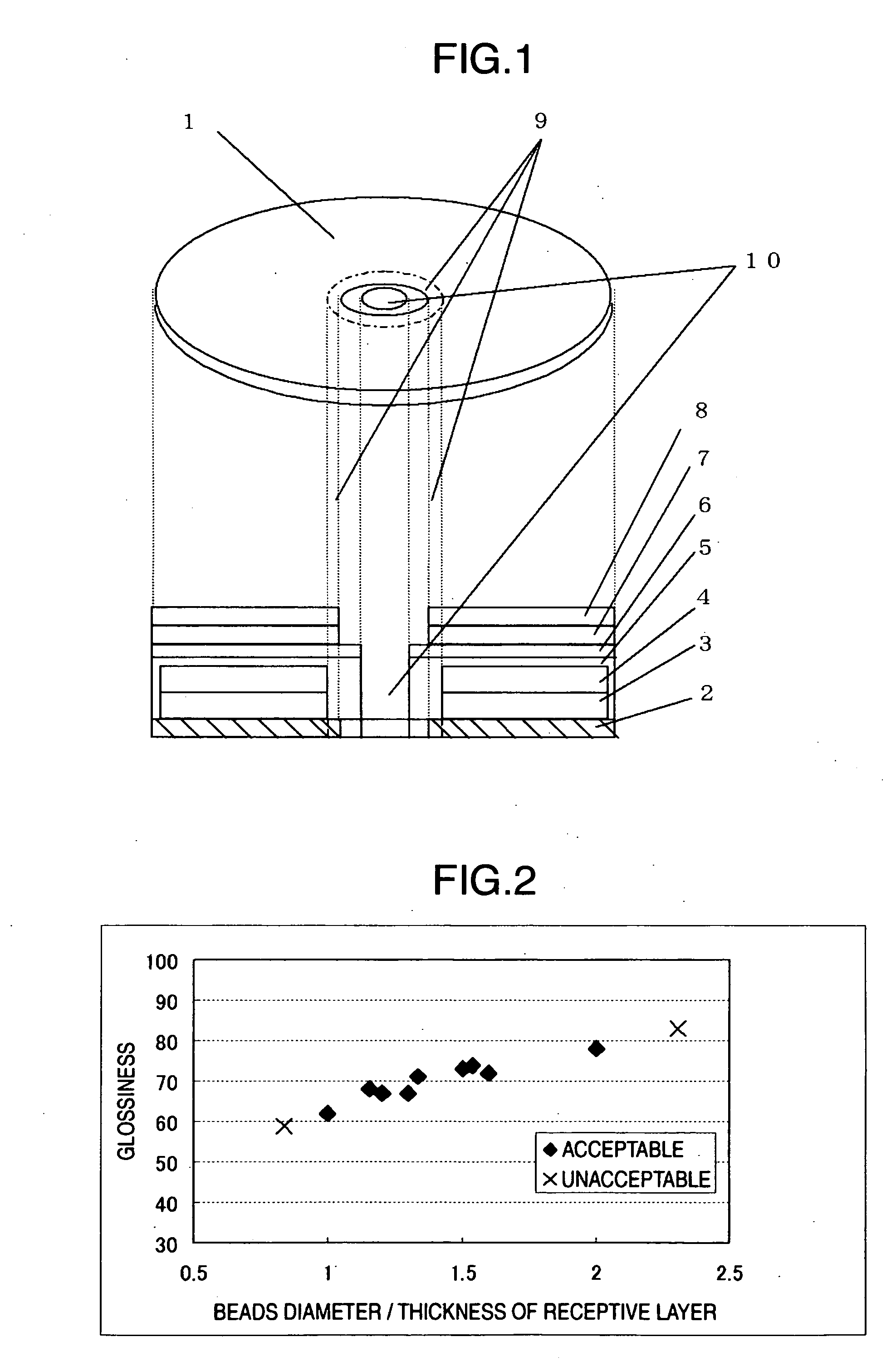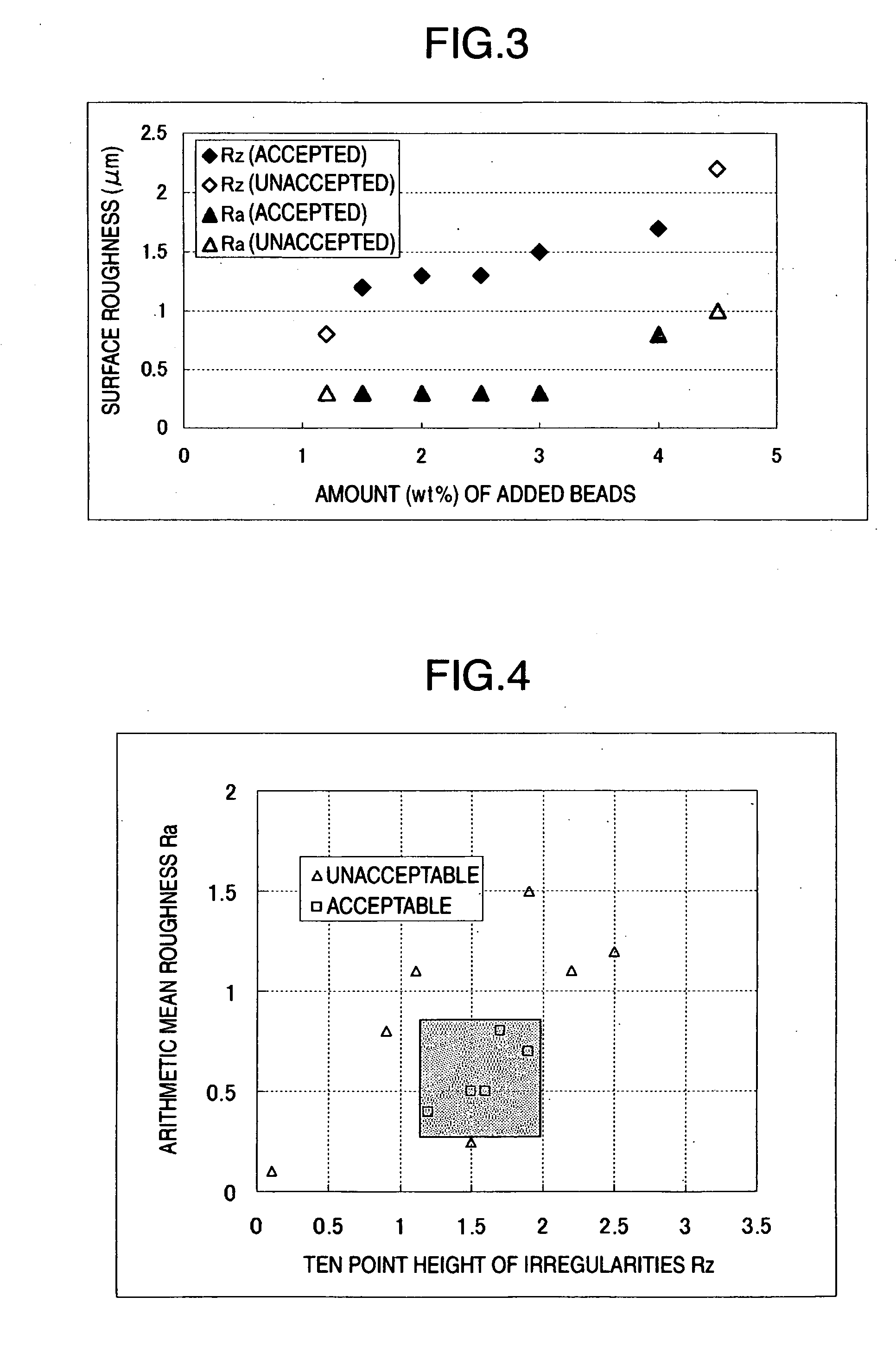Optical disk and manufacturing method therefor
a technology of optical disks and manufacturing methods, applied in the field of optical disks, can solve the problems of difficult to impart the glossiness of receptive layer surfaces, inability to save printed images, etc., and achieve the effect of adequate roughness
- Summary
- Abstract
- Description
- Claims
- Application Information
AI Technical Summary
Benefits of technology
Problems solved by technology
Method used
Image
Examples
example 1
Relationship Between Bead Diameter and Thickness of Receptive Layer
(Sample A)
[0046] A recording layer 3 with the thickness of 150 nm was formed on a signal surface of a transparent substrate 2 with the thickness of 0.6 mm made from polycarbonate by spin-coating a coloring matter dissolved in tetrafluoropropanol. A reflective layer 4 made from a silver alloy was layered thereon by sputtering.
[0047] The surface of the reflective film 4 was spin-coated with an ultraviolet-curing adhesive, a dummy substrate with the same shape as the discoid transparent substrate 2 made from polycarbonate was laminated thereon, and then the adhesive was cured by being irradiated with an ultraviolet light of a high-pressure mercury lamp from a dummy substrate side.
[0048] Subsequently, a white underlayer 7 was formed on the surface of a region between a radius of 10 mm and a radius of 59 mm in the dummy substrate 6, by fixing a white UV link with a screen printing method and irradiating it with ultra...
example 2
Relationship Between Amount of Added Transparent Resin Beads and Surface Roughness
(Sample J)
[0068] An optical disk was prepared with the same method as in the case of Sample A, except that a conditioned ink containing 1.5 wt % acrylic beads with the average particle diameter of 15 μm for a receptive layer was applied on an underlayer so as to form a film with the thickness of 13 μm.
(Sample K)
[0069] An optical disk was prepared with the same method as in the case of Sample A, except that a conditioned ink containing 1.2 wt % acrylic beads with the average particle diameter of 15 μm for a receptive layer was applied on an underlayer so as to form a film with the thickness of 13 μm.
(Sample d)
[0070] An optical disk was prepared with the same method as in the case of Sample A, except that a conditioned ink containing 4.5 wt % acrylic beads with the average particle diameter of 15 μm for a receptive layer was applied on an underlayer so as to form a film with the thickness of 13 ...
example 3
Relationship Between Arithmetic Mean Roughness Ra and Ten Point Height of Irregularities Rz
(Sample C)
[0071] An optical disk was prepared with the same method as in the case of Sample A, except that a conditioned ink containing 2.5 wt % acrylic beads with the average particle diameter of 15 μm for a receptive layer was applied on an underlayer so as to form a film with the thickness of 13 μm.
(Sample N)
[0072] An optical disk was prepared with the same method as in the case of Sample A, except that a conditioned ink containing 4 wt % acrylic beads with the
[0073] An optical disk was prepared with the same method as in the case of Sample A, except that a conditioned ink containing 2 wt % acrylic beads with the average particle diameter of 15 μm for a receptive layer was applied on an underlayer so as to form a film with the thickness of 13 μm.
(Sample L)
[0074] An optical disk was prepared with the same method as in the case of Sample A, except that a conditioned ink containing 2...
PUM
| Property | Measurement | Unit |
|---|---|---|
| arithmetic mean roughness | aaaaa | aaaaa |
| arithmetic mean roughness | aaaaa | aaaaa |
| height | aaaaa | aaaaa |
Abstract
Description
Claims
Application Information
 Login to View More
Login to View More - R&D
- Intellectual Property
- Life Sciences
- Materials
- Tech Scout
- Unparalleled Data Quality
- Higher Quality Content
- 60% Fewer Hallucinations
Browse by: Latest US Patents, China's latest patents, Technical Efficacy Thesaurus, Application Domain, Technology Topic, Popular Technical Reports.
© 2025 PatSnap. All rights reserved.Legal|Privacy policy|Modern Slavery Act Transparency Statement|Sitemap|About US| Contact US: help@patsnap.com


